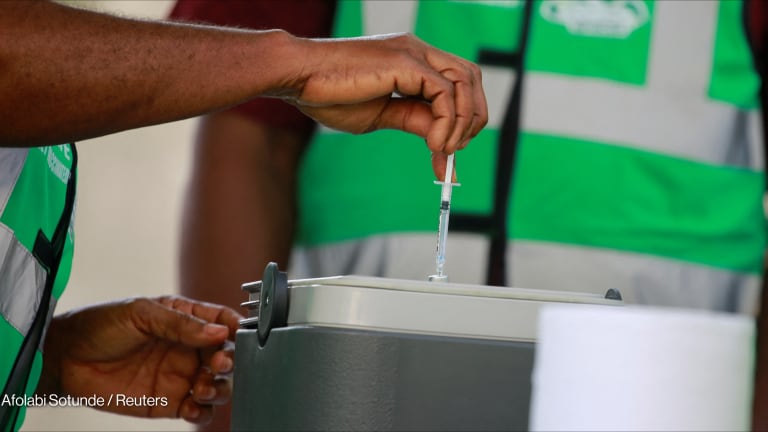
NAIROBI — A year and a half after the Ebola outbreak in the Democratic Republic of the Congo began, the last patient has been discharged from a treatment center this week from the north-eastern town of Beni. This sets in motion a 42-day surveillance period before the outbreak is deemed officially over.
Since the outbreak was declared in Aug. 2018, 3,444 people have contracted the virus and about two-thirds of those infected have died. Recently, Beni was the only health zone reporting cases but in the past two weeks, there have been no new cases.
“We are afraid if the donors do not pledge, we may have a shortage of funding.”
— Dr. Abdou Salam Gueye, DRC incident manager, WHOThis is the first time over the past year and a half that the response has entered into an observation period, according to Dr. Abdou Salam Gueye, DRC incident manager at the World Health Organization.
“We have cautious optimism, but not naive optimism,” he said.
The Ebola response, which has been marred by community resistance and violence against health workers, started to change strategy last June, Salam Gueye said. This, along with progress made on the Ebola vaccine, led to a reduction in new cases — ultimately leading to this final patient at the treatment center.
Under guidance from WHO, the last patient received two tests — separated by 48 hours. When the second test returned negative, the 42-day countdown started, which is the equivalent of two incubation periods of the virus. If there are no new cases by the end of this period, WHO will declare the end of the outbreak. The countdown started on March 2.
“This is very encouraging, but the outbreak is not over and we are still in full response mode,” tweeted WHO Director-General Tedros Adhanom Ghebreyesus.
During the observation period, all surveillance should be maintained and preferably be reinforced, Salam Gueye said. Surveillance systems are coordinated by the government of DRC and supported by WHO and other international organizations.
There are several types of surveillance. During the response, community-based surveillance was put in place. In Beni, for example, there are about 1,700 people that are part of this group. They report signs of illness in the community to Ebola responders, he said. Health workers are also trained to identify symptoms in patients and report them to the Ebola response teams. Teams of epidemiologists also visit health clinics to check on people at the facility and look through the facility’s registry to analyze the symptoms of patients who have been seen.
When there are suspected cases, responders analyze the case and test for the virus.
Insecurity in the region has forced responders to access some areas in irregular ways. For example, when reports are received of symptoms in areas that can’t be accessed, suspected cases come to safe areas, like Beni, and responders observe them and treat them if necessary. The responders then keep in touch with those individuals when they return home.
Using this tactic, individual cases can be missed but clusters won’t be missed, Salam Gueye said.
All of these activities will continue through the observation period, he continued.
Additionally, during this observation period, all deaths are considered suspected cases and are tested, as a safety net to ensure no cases are missed.
“We are ready to react if there are cases anywhere,” Salam Gueye said. “Where we are present, we hope to detect them very early and where we are not present, we will do our best. We may miss one or two cases, but the system we put in place is capable of detecting any clusters of cases.”
Though a clear set of plans are in place, funding shortages could complicate efforts, he said.
The current strategic response plan — which outlines the response activities needed to end the outbreak — calls for an estimated $83 million from January to June to fund the response, but WHO said it still needs $40 million. Funds are also needed for surveillance efforts and to keep treatment centers active to manage suspected cases.
“We are afraid if the donors do not pledge, we may have a shortage of funding,” Salam Gueye said. “Before we declare an end to Ebola, we should do due diligence to show the international community and our donors, that there's really no case of Ebola. This will help us to avoid coming back here in two or three months and managing another cluster.”
But the media attention around the coronavirus outbreak might distract from raising funds for Ebola. It was easier to raise money during the past strategic plan than the current one, even though less money is needed, Salam Gueye said.
“Maybe there is a fatigue or distraction toward COVID 19,” he said.
If this is truly the end of the Ebola outbreak in the DRC, this could mean that more attention can be paid to other outbreaks in DRC, including the world’s worst measles outbreak, as well as prevention efforts for a COVID-19 outbreak.
“The attention was mostly directed toward Ebola because it is a very dangerous disease and it is a disease that people are afraid has a lot of capacity to go from one country to another,” he said. This could mean more resources and more health care workers available to tackle these outbreaks.
Following a declaration of the end of Ebola, WHO has a 90-day plan to continue surveillance activities in DRC. NGOs will also continue to remain involved after the outbreak. Mercy Corps, for example, said it will continue its work on community engagement and WASH until at least October.
Previous experience and scientific evidence shows that survivors can harbor the virus, especially in semen, for a period of up to two and a half years, according to Mercy Corps. Because of this, community-based monitoring of survivors in the months to come is also crucial.
Because Ebola is endemic in DRC, continuing efforts to prepare for a future outbreak, as well as encouraging people to get the vaccine, are also crucial, according to the NGO.
Salam Gueye said there are also long-term efforts to work with the government on roadmaps to improve overall health systems, financial access to health services and prevention efforts for further outbreaks.








